By G. Richard D. Batstone, MA, MB, BChir, MD (Cantab), FRCS (Urol), FRACS, FRCSC
Because of the risks and facility requirements for some common urological procedures, such as treatment of large kidney stones and benign prostatic hyperplasia (BPH), small hospitals in rural areas will often refer those cases to larger facilities. For the last 6 years, I’ve been following a different model. I perform kidney stone and BPH procedures 3 days a week at one base in Bangor, Maine, and then travel 85 miles 2 days a week to do surgery in Farmington, a rural town of about 8,000 residents. By treating patients locally, we reduce the impact on their lives and finances, and the rural hospital retains high-volume prostate and stone operations. As a surgeon, I enjoy operating at small hospitals, where the logistical and bureaucratic setup allows me to turn cases quickly and perform more surgeries per day.
I think this approach – taking surgeons to the patients – will be the model of the future. But this model relies on procedures being very safe, thus not requiring a high-level facility or the surgeon’s presence after surgery. In urology, the change is possible because of an advance in laser technology, utilized through flexible ureteroscopy, which dramatically shifts the safety profile for treating even the toughest kidney stone and BPH cases. It lets me safely operate and drive home the same day.
Safety Makes It Possible
Kidney stones and BPH are highly prevalent conditions that have traditionally been underserved by minimally invasive techniques. Although laser stone “dusting” with flexible ureteroscopy has been available for years, patients with stones are still likely to have shockwave lithotripsy or percutaneous nephrolithotomy (PCNL). Men with BPH are more likely to have transurethral resection of the prostate (TURP) than holmium laser enucleation of the prostate (HoLEP), a procedure with much fewer complications and bleeding.
There is a shift, however, to less invasive techniques. At both my urban and rural hospitals, I now use a 120-watt holmium laser that incorporates the “MOSES Technology” to dust all kidney and urinary stones. This includes large or staghorn stones, for which rural patients are typically referred to the city for PCNL. Compared to PCNL, laser dusting using ureteroscopic access does not involve the puncturing of the kidney, uses no nephrostomy tube through the patient’s back, has a lower infection rate, and causes less bleeding and pain. Usually, there is no overnight stay – patients will often go home a few hours after surgery.
At both of my hospitals, I perform HoLEP for BPH using flexible ureteroscopy and the same 120-watt holmium laser with MOSES Technology. I even use HoLEP on massive prostates that would otherwise require referral to a tertiary center for TURP, a more invasive procedure. I schedule HoLEP patients as day cases – not the overnight stay TURP recipients require for irrigation, bleeding, and potential transfusion.
Because the 120-watt holmium MOSES laser is usually more efficient for both prostate and stones procedures, this modality doesn’t carry some of the requirements that make other approaches impossible in the rural hospital. For example, it may eliminate the need for an interventional radiologist, ICU, or access to blood products. It requires fewer disposables and less equipment than other approaches as well.
These minimally invasive procedures often do not require postoperative supervision or inpatient care. The risk of complications is low, and I have kept my transfusion rate to zero for both procedures. I go home to Bangor after surgery, while my physician assistant remains in Farmington 5 days a week for follow-up.
Rural Hospitals Capitalize
Stones and BPH are ubiquitous, and the demand for treatment is very high. A single laser and very precise and effective techniques let the hospital treat all stages of both conditions instead of sending patients away. As a rural hospital’s own surgeons develop their expertise with the technology and word gets out about these procedures, rural hospitals can actually draw patients from outside their region.
My hospital in Farmington loves this laser and has just purchased a second one. As more hospitals follow suit with surgical technology purchases for urology and other specialties, we will see more patients in rural areas receiving advanced, minimally invasive treatment close to home.
G. Richard D. Batstone, MA, MB, BChir, MD (Cantab), FRCS (Urol), FRACS, FRCSC, is an urologist at Northern Lights Urology in Bangor, Maine, and Franklin Health Urology in Farmington, Maine.
The content presented on this page is provided for informational and/or educational purposes. This material represents the views and opinions of its authors and should not be construed as representing or reflecting the official position, views or opinions of the Society of Laparoendoscopic Surgeons. The authors of the work are solely responsible for its content.



